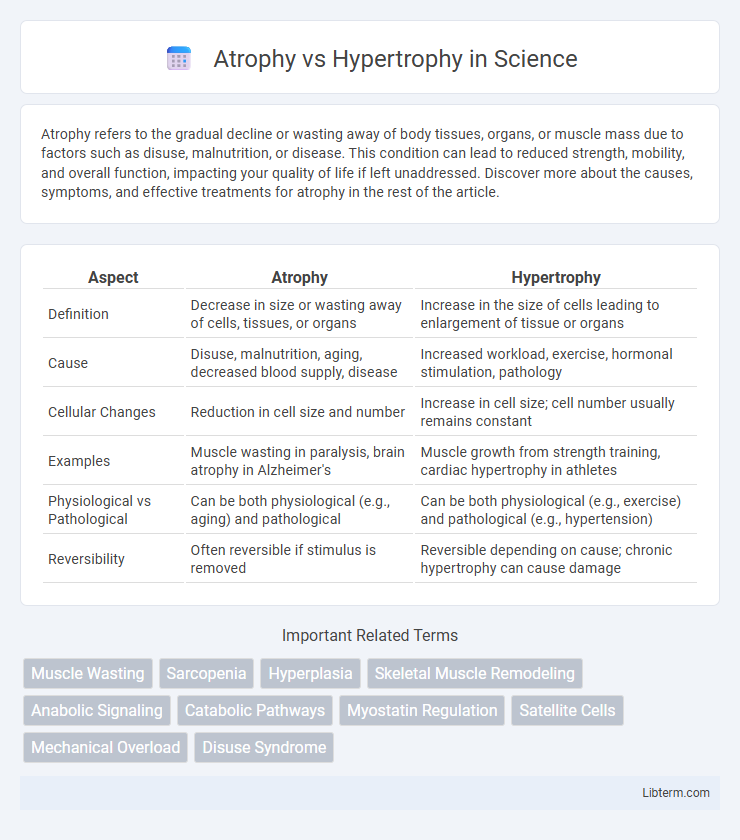Atrophy refers to the gradual decline or wasting away of body tissues, organs, or muscle mass due to factors such as disuse, malnutrition, or disease. This condition can lead to reduced strength, mobility, and overall function, impacting your quality of life if left unaddressed. Discover more about the causes, symptoms, and effective treatments for atrophy in the rest of the article.
Table of Comparison
| Aspect | Atrophy | Hypertrophy |
|---|---|---|
| Definition | Decrease in size or wasting away of cells, tissues, or organs | Increase in the size of cells leading to enlargement of tissue or organs |
| Cause | Disuse, malnutrition, aging, decreased blood supply, disease | Increased workload, exercise, hormonal stimulation, pathology |
| Cellular Changes | Reduction in cell size and number | Increase in cell size; cell number usually remains constant |
| Examples | Muscle wasting in paralysis, brain atrophy in Alzheimer's | Muscle growth from strength training, cardiac hypertrophy in athletes |
| Physiological vs Pathological | Can be both physiological (e.g., aging) and pathological | Can be both physiological (e.g., exercise) and pathological (e.g., hypertension) |
| Reversibility | Often reversible if stimulus is removed | Reversible depending on cause; chronic hypertrophy can cause damage |
Understanding Atrophy and Hypertrophy
Atrophy refers to the decrease in muscle mass and strength due to disuse, aging, or disease, resulting in the shrinkage of muscle fibers and loss of cellular components. Hypertrophy involves the enlargement of muscle cells through increased protein synthesis, typically stimulated by resistance training or mechanical overload, leading to greater muscle size and strength. Understanding these processes helps optimize physical training, rehabilitation, and management of muscle-related conditions.
Key Differences Between Atrophy and Hypertrophy
Atrophy involves the reduction in muscle size due to decreased muscle fiber volume, often caused by disuse, aging, or disease, whereas hypertrophy refers to the increase in muscle size resulting from enhanced muscle fiber growth triggered by resistance training or increased workload. Atrophy is characterized by a breakdown of proteins and loss of muscle mass, while hypertrophy involves protein synthesis and muscle fiber enlargement. The primary distinction lies in their opposite effects on muscle morphology and cellular activity, with atrophy representing degeneration and hypertrophy reflecting adaptation and growth.
Causes of Muscle Atrophy
Muscle atrophy occurs due to factors such as prolonged immobilization, aging (sarcopenia), malnutrition, and neurological conditions like amyotrophic lateral sclerosis (ALS) or peripheral neuropathy. Disuse atrophy results from lack of physical activity or immobilization after injury, leading to decreased muscle fiber size and strength. Chronic diseases such as cancer, AIDS, or chronic obstructive pulmonary disease (COPD) also contribute to muscle wasting through systemic inflammation and metabolic disturbances.
Factors Leading to Muscle Hypertrophy
Muscle hypertrophy primarily results from progressive overload through resistance training, which stimulates muscle fiber growth and increased protein synthesis. Nutritional factors such as adequate protein intake, along with sufficient calorie consumption and hormone regulation involving testosterone, growth hormone, and insulin-like growth factor 1 (IGF-1), also play critical roles. Recovery periods, including sleep and rest, are essential to repair muscle tissues and enhance hypertrophic adaptations.
Biological Mechanisms of Atrophy
Atrophy is characterized by the reduction in cell size and number due to decreased protein synthesis and increased protein degradation, primarily mediated by ubiquitin-proteasome and autophagy-lysosome pathways. Key regulators include the downregulation of anabolic signals such as IGF-1/Akt/mTOR and upregulation of catabolic factors like FOXO transcription factors and muscle-specific E3 ubiquitin ligases, MuRF1 and Atrogin-1. Cellular energy deficits and oxidative stress also trigger atrophy through activation of AMPK and NF-kB pathways, promoting muscle protein breakdown and impaired mitochondrial function.
Cellular Processes in Hypertrophy
Hypertrophy involves the enlargement of cells through increased protein synthesis and organelle expansion, primarily driven by mechanical stress and growth factor signaling pathways such as mTOR. This cellular process enhances cell size without division, resulting in greater functional capacity, particularly in muscle tissue. Increased satellite cell activation and gene expression changes support sustained hypertrophic growth and tissue remodeling.
Symptoms and Signs of Atrophy
Atrophy presents with symptoms such as muscle weakness, decreased muscle size, and reduced strength, often noticeable as muscle wasting or thinning. Signs include visible shrinkage of affected muscles, loss of muscle tone, and diminished reflexes in severe cases. These symptoms often correlate with underlying conditions like nerve damage, malnutrition, or disuse.
Benefits and Risks of Hypertrophy
Hypertrophy, characterized by the increase in muscle size through resistance training, enhances muscle strength, metabolic rate, and overall physical performance, contributing to improved athleticism and injury prevention. The benefits of hypertrophy include increased muscle endurance, better glucose metabolism, and heightened bone density, promoting long-term health and functional capacity. Risks involve potential muscle strain, joint stress, and overtraining, which can lead to injury if recovery and proper technique are neglected.
Prevention and Treatment Strategies
Prevention and treatment strategies for atrophy emphasize regular resistance training, adequate protein intake, and addressing underlying medical conditions such as malnutrition or nerve damage. Hypertrophy prevention and treatment focus on structured strength training programs, proper recovery periods, and nutritional support rich in essential amino acids and calories to enhance muscle growth. Both conditions benefit from personalized exercise regimens and medical supervision to optimize muscle health and functional capacity.
Atrophy vs Hypertrophy: Summary and Key Takeaways
Atrophy refers to the decrease in muscle mass due to disuse, aging, or disease, while hypertrophy is the increase in muscle size primarily from resistance training or anabolic stimuli. Key takeaways highlight that atrophy results in weakened muscle function and metabolic decline, whereas hypertrophy enhances strength and metabolic activity. Understanding these processes is crucial for designing effective rehabilitation and fitness programs targeting muscle maintenance and growth.
Atrophy Infographic

 libterm.com
libterm.com